Visit Valley of Flowers, Uttarakhand in Monsoon with the New Global Update Team.
Welcome to the Valley of Flowers Trek, where Mother Nature went full Picasso. Situated in the Chamoli district of Uttarakhand at an altitude of 11,811 feet, the Valley of Flowers, also known as ‘Foolo ki Ghati,’ is a stunning natural wonder. The views from the top are therapeutic, almost as if the entire scene has been photoshopped. Home to over 600 flower and plant species and several endangered animals, it has been declared a UNESCO World Heritage site and is considered ‘the most beautiful monsoon trek in India.’
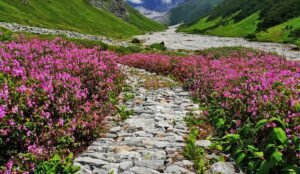
Unique Flora
The Valley of Flowers boasts rare and uncommon species of plants and flowers. You’ll be amazed by their colors, textures, and unique characteristics. Some of these flowers hold significance in ancient stories and mythology, such as:
- Brahma Kamal: A sacred mythical flower that blooms late in the evening.
- Blue Poppy: A striking blue flower.
- Cobra Lily: A peculiar flower with a cobra-like hood.
- Bistorta Affinis: A pink/purple flower with dense spikes.
- Himalayan Edelweiss: A woolly flower found only at high altitudes.
- Saxifraga Brunonis: Delicate pink or white flowers, often seen in photos.
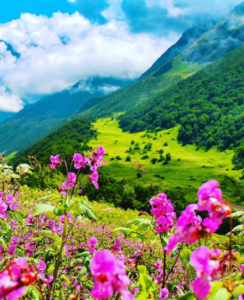
Notable Attractions
During the trek to the Valley of Flowers, you’ll visit remarkable places like Hemkund Sahib Gurudwara, the highest Gurudwara in the world. Pilgrims yearn to visit this sacred site, where Guru Gobind Sahib is believed to have meditated for over ten years. Trekkers are also rewarded with a visit to the Laxman Lokpal Temple, situated at an altitude of 15,225 feet by the banks of the Hemkund River. This temple is believed to be where Shesha Naag (the snake god) was reborn as Laxman.
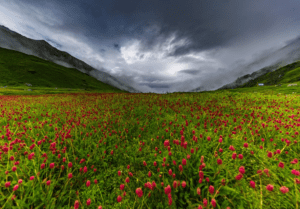
Historical Significance
In ancient mythology and popular belief, the Valley of Flowers was considered the abode of fairies and devtas. The beauty of the valley makes this easy to believe.
The Valley of Flowers was discovered in 1931 by two British mountaineers who stumbled upon the route after getting lost. Captivated by its beauty, they named it the Valley of Flowers. Since then, it has attracted botanists and researchers from around the world.
How to Reach the Valley of Flowers
The Valley of Flowers trek commences from Govindghat. To reach Rishikesh, you can travel by road, rail, or air, depending on your location and preferences. The nearest airport to Rishikesh is Jolly Grant Airport, the nearest railway station is Haridwar Junction Railway Station (25 km away), and the closest bus stand is in Rishikesh. The distance from Rishikesh to Govindghat is 268 km, which takes about 7-8 hours.

Best Time to Visit
The Valley of Flowers is best visited during the monsoon season, from July to September, when the flowers are in full bloom. The narrow window for visiting is 4 to 5 months a year.
- Budget Friendly Explore Nainital Adventure with the NGU Travel Guide Team.
- Explore Greece with Our Budget Package.
- Planning a Trip to Manali in July Your Ultimate Guide.
Weather
Monsoon brings rain, but it is usually not very heavy. Expect rain every 2-3 days, and be prepared with appropriate rain gear. Daytime temperatures range between 14-18 degrees Celsius, while nights can be as cold as 3-4 degrees.
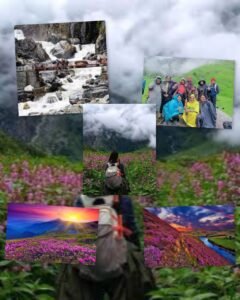
Trek Route, Distance, and Duration
The journey to the Valley of Flowers starts from Govindghat, with a trek to Ghangaria (13 km, taking about 6-8 hours). From Ghangaria, two routes lead to Hemkund Sahib and the Valley of Flowers. Ghangaria serves as the base camp. The trek from Ghangaria to the Valley of Flowers is 4 km (approximately 4 hours one way), while the trek to Hemkund Sahib is 3-4 km (4-5 hours). The total trek length for the Valley of Flowers is approximately 38 km.
Trek Difficulty and Elevation
- Difficulty: The Valley of Flowers is a moderate trek, suitable for beginners with a good fitness level and stamina.
- Elevation: The trek starts at 6,300 feet, rising to 9,600 feet at Ghangaria. The highest altitude on the trek is 14,300 feet at Hemkund Sahib.
Cost and Packages
- Trek Packages: Prices range from Rs. 12,000 to Rs. 20,000, depending on the services provided and whether Hemkund Sahib is included in the itinerary.
- Porter Services: Porters, known as Sherpas, can carry your luggage or even you. They charge around Rs. 4,000-5,000 for the Valley of Flowers trek and Rs. 7,000-8,000 for Hemkund Sahib. Prices may vary according to season, porter, and weight.
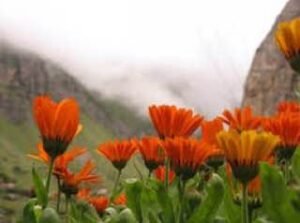
Local Laws and Guidelines
- Camping is not allowed in the Valley of Flowers.
- Entry is permitted only between 7 am to 12 pm.
- Drone cameras are prohibited.
- Smoking and drinking are banned.
- Polythene use is not tolerated.
- Firearms are restricted.
- Different charges apply for professional cameras and footage use for Indians and foreigners (Rs. 500 to Rs. 1,00,000).
- No littering is allowed; fines may be imposed.
- An entry fee of approximately Rs. 150 is required.
Do’s and Don’ts
Don’ts:
- Don’t be careless on slippery rocks and near rivers.
- Don’t come unprepared for steep inclines and long trekking hours.
- Don’t forget to acclimatize properly.
Do’s:
- Carry food and refreshments, as there are no food options in the Valley of Flowers.
- Equip yourself with rain gear for both yourself and your backpack.
- Start exercising and running/jogging at least 30 days before the trek.
Embark on the Valley of Flowers trek for a mesmerizing experience filled with natural beauty, tranquility, and adventure.
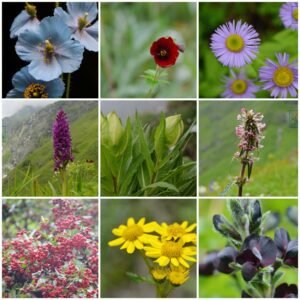
FAQ
- When is the best time to visit the Valley of Flowers?
- The best time to visit the Valley of Flowers is during the monsoon season, from July to September. This is when the flowers are in full bloom, creating a vibrant and colorful landscape.
2. How do I reach the Valley of Flowers?
- The trek to the Valley of Flowers starts from Govindghat. To get to Govindghat, you can travel to Rishikesh by road, rail, or air. The nearest airport is Jolly Grant Airport in Dehradun, and the nearest railway station is Haridwar Junction Railway Station. From Rishikesh, you can take a bus or taxi to Govindghat, which is about a 7-8 hour drive (268 km).
3. What is the difficulty level of the Valley of Flowers trek?
- The Valley of Flowers trek is considered to be of moderate difficulty. It is suitable for beginners with a good fitness level and stamina. The trek involves walking long distances and some steep inclines, so proper preparation and acclimatization are important.
4. Are there any accommodation options during the trek?
- Accommodation options are available in Ghangaria, which serves as the base camp for the Valley of Flowers trek. You can find guesthouses, lodges, and campsites in Ghangaria. Camping is not allowed within the Valley of Flowers itself.
5. What should I pack for the Valley of Flowers trek?
- For the Valley of Flowers trek, you should pack essentials such as sturdy trekking shoes, rain gear, warm clothing, a backpack, a water bottle, snacks, personal medications, a first aid kit, a flashlight, and a camera. Additionally, carry proper rain protection for both yourself and your backpack, as the monsoon season can bring frequent showers.

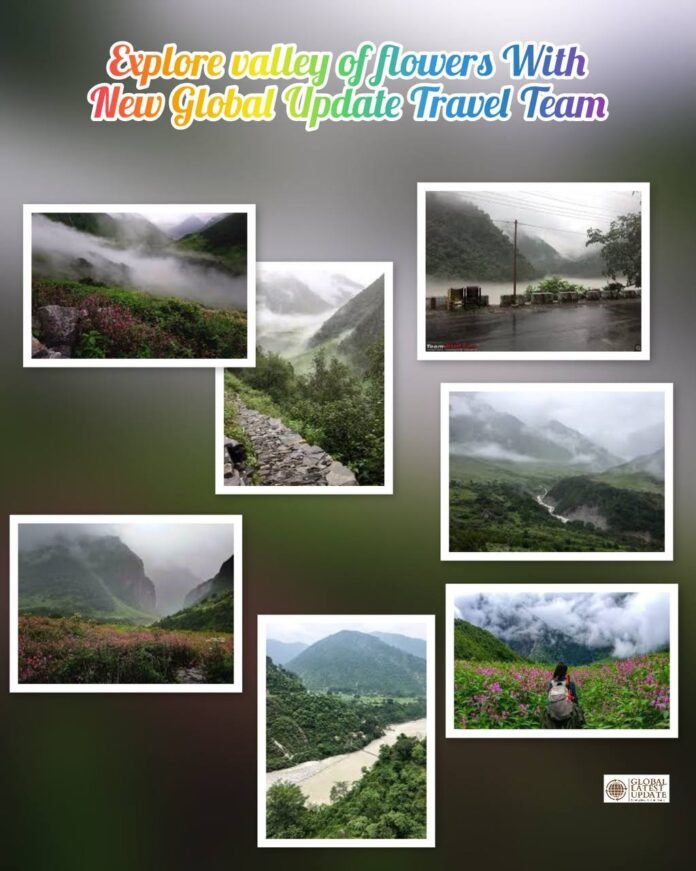
Such a Beautiful place..Must visit !!
Thanxxx for ur great services..Everything worked out great 👍🏻